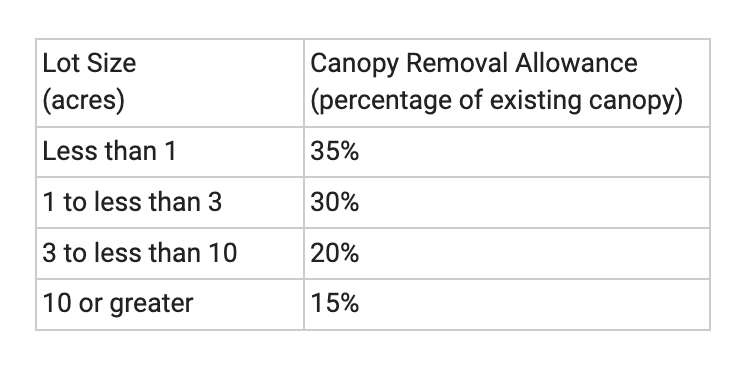We’re pleased to share that last night, the Whatcom County Council passed an important set of updates to the Lake Whatcom Overlay District Code that will increase tree retention requirements, a boon for local efforts to protect the drinking water supply for more than 100,000 Whatcom County residents.
If you live in the Lake Whatcom watershed and you feel like your neighborhood has been losing a lot of trees lately, you’re probably not imagining things. Through both new development and existing landowner activity, trees are coming off the landscape at an unsustainable pace. As new development continues in parts of the watershed, and property owners look to improve lakeviews, build additions, or make other changes that add to a property’s footprint, trees are removed. While at the scale of a single property this might not appear significant, the cumulative impacts and implications for our broader region are consequential.
For years, RE Sources and other local advocates have worked to protect Lake Whatcom’s water quality, and it is a core part of our policy vision for this region. That’s because the Lake Whatcom Reservoir is the drinking water source for about half of Whatcom County’s residents, including all Bellinghamsters. Despite its critical importance, the Lake’s water quality is threatened by a number of water quality problems, among them excessive amounts of phosphorus.
This naturally-occurring nutrient makes its way to the lake when construction and logging activities disturb the soil, and also when stormwater runs off from lawns and impervious surfaces. Since 1998, Lake Whatcom has been listed as a polluted waterbody because it fails to meet the State’s dissolved oxygen standards, which is most directly tied to high amounts of phosphorus entering the lake. If we don’t address our phosphorus problem, we risk making our water treatment much more complex and expensive, hitting our wallets both in the terms of utility bills and local taxes.
Clean drinking water is paramount, especially for a region with a rapidly growing population and a changing climate. Our region’s forests serve as natural sponges that retain and filter rainfall and help balance phosphorus levels in nearby waterways. In fact, the State’s clean-up plan for Lake Whatcom identifies the need to increase natural forest cover in the watershed to help filter out sediments and contribute to hydrologic benefits.
In addition to their watershed benefits, healthy forests can provide shade and cooling benefits along with critical wildlife habitat. Pacific Northwest forests also serve as some of the best acre-for-acre carbon sinks in the world, offering vital natural climate solutions. One of the most effective and straightforward climate actions we can take locally is to protect and retain the trees currently on the landscape. As climate change brings wetter winters and hotter, drier summers, our forests already face threats from diseases like laminated root, pest infestations and heat stress. Now is the exact wrong time to be wiping healthy trees off the map.
That’s why RE Sources and the Whatcom Million Trees Project worked with County staff and the Whatcom County Planning Commission to develop a suite of updates to the Lake Whatcom Overlay District that will help retain tree cover in developed and developable areas in the watershed while providing landowners with sufficient flexibility to manage their properties. There were four major updates to the Lake Whatcom Overlay District:
- Lower tree removal allowances in instances not related to development.
Current rule: Landowners are allowed to remove up to 35% of existing canopy as of 1/1/2017. Updated rule: Landowners are allowed to remove 20% of existing canopy, with a maximum allowance of 14,000 sq ft (1/3 of an acre).

- Lower tree removal allowances in development-related instances.
Current rule: Landowners are allowed to remove up to 35% of existing canopy or 5,000 sq feet – whichever is greater). Updated rule: Landowners are allowed to remove a certain percentage of existing canopy as determined by this table (tiered based on lot size):


- Strengthen the penalty for non-compliance.
Updated rule: Cutting down trees without obtaining the right permit requires the landowner to plant three trees for each tree removed (fines may or may not be issued). The updated code also outlines the standards for what counts as a “replacement tree,” and gives County staff some discretion on how to work with non-compliant landowners to ensure replacement trees are appropriately maintained. - Require more stormwater infrastructure to be installed when development occurs.
Updated rule: Lower the threshold of how much new impervious surface area is exempt from installing a stormwater filtration system from 500ft² to 200ft². Essentially this means more landowners will have to install stormwater infrastructure when building new structures, driveways, or other impervious surfaces.
The details of the district code might be a bit wonky, but we are confident these updates will result in greater tree retention on thousands of acres of developed and developable lands in the watershed. For property owners in the watershed, the stronger tree retention rules balance legitimate needs for tree removal with shared community needs for clean drinking water, climate resilience, and the verdant landscapes that help make the region such a great place in which to live, work and play. It’s a fair deal considering many cities in the Northwest, including Portland, Seattle, Everett, and others, have protected their drinking watersheds from development and logging entirely in order to protect such a precious resource.
To stay up to date on these ongoing efforts, make sure you’re signed up for our mailing list, and opt in to receive Action Alerts. You’ll never miss an opportunity to make your voice heard when it comes to protecting our region’s forests and waters.
We commend the Whatcom County Council and the Planning Commission for taking this important step to retain tree cover in our drinking watershed, and we look forward to working with them on more efforts to improve and protect the health of Lake Whatcom moving forward.
*Header photo courtesy of John D’Onofrio



